
US in biggest designer drug ring bust, with 225 arrests in five countries
Raids in five countries net synthetic products made in Asia and used to fund terror groups
US officials have announced the largest-ever bust of a global synthetic drugs ring, arresting 225 people in five countries and 35 American states.
Authorities seized 1.5 tonnes of "dangerous designer synthetic drugs" manufactured in Asia and trafficked to the US and Australia.
The Drug Enforcement Administration (DEA) said Project Synergy began last December but culminated on Wednesday, when most of the arrests were made. The drugs are created in unregulated labs mainly in China and India, it said.
Nearly US$15 million in cash and assets were seized in the operation, which saw arrests or search warrants executed in 35 US states, 49 cities and the countries of Australia, Barbados, Canada and Panama.
Millions of dollars in drug sale profits were being funnelled to the Middle East, potentially into existing terror networks that are known to fund their illicit operations through drug trafficking, officials said.
The designer drugs, which mimic controlled substances, are among a growing group of illicit compounds that traffickers have marketed in recent years, often attempting to skirt laws by barely modifying the chemical make-up of products like incense, bath salts or jewellery cleaner.

The drugs - synthetic cannabinoids that can provide a marijuana-like high, or synthetic cathinones that are stimulant hallucinogens - are marketed under brand names like "Spice," "K2" or "Bliss" and sold in colourful, youth-oriented packaging, often with comic book characters on the cover.
US officials say abuse of the drugs can lead to seizures, hallucinations, high blood pressure and organ damage.
Several overdoses, mainly of people aged 12 to 29, have led to deaths, the DEA said.
"The bottom line is that these drugs are being marketed to the most vulnerable part of our society, which is teenagers and young adults," said DEA chief of operations James Capra.
He added: "You have this convergence out there, more so today than ever before, of terror groups funding their operations through the sale of narcotics around the globe."
The traffickers have convinced distributors including some gas stations and convenience stores that their drugs are legal, when in fact they are sometimes dangerous alterations of permitted products.
"It's marketed 'not for human consumption,' but it's killing kids," warned Derek Maltz, who heads the Justice Department's Special Operations Division.
Australia's Acting Ambassador to the US Graham Fletcher said the seizure "is a terrific result for law enforcement agencies across the globe".
Many similar products have been legal for years. But traffickers began tweaking the chemical components to increase their psychotic effects.
The nearly inexhaustible chemical combinations available to the drugs' creators make it a struggle for authorities to keep up. "It's much more than a two-dimensional bath salts and 'Spice' problem," said Special Agent Robert Bell, of DEA's Office of Diversion Control.
"There have been more than 200 brand new drugs introduced into the US since 2009."
